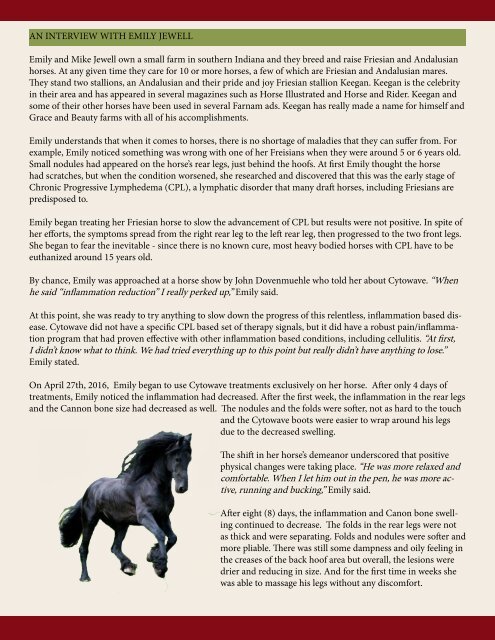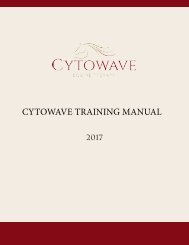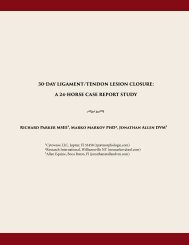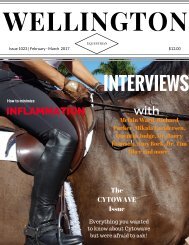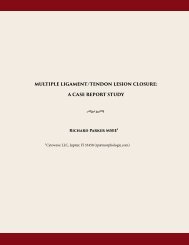CPL JD final with Keegan pictures
You also want an ePaper? Increase the reach of your titles
YUMPU automatically turns print PDFs into web optimized ePapers that Google loves.
AN INTERVIEW WITH EMILY JEWELL<br />
Emily and Mike Jewell own a small farm in southern Indiana and they breed and raise Friesian and Andalusian<br />
horses. At any given time they care for 10 or more horses, a few of which are Friesian and Andalusian mares.<br />
They stand two stallions, an Andalusian and their pride and joy Friesian stallion <strong>Keegan</strong>. <strong>Keegan</strong> is the celebrity<br />
in their area and has appeared in several magazines such as Horse Illustrated and Horse and Rider. <strong>Keegan</strong> and<br />
some of their other horses have been used in several Farnam ads. <strong>Keegan</strong> has really made a name for himself and<br />
Grace and Beauty farms <strong>with</strong> all of his accomplishments.<br />
Emily understands that when it comes to horses, there is no shortage of maladies that they can suffer from. For<br />
example, Emily noticed something was wrong <strong>with</strong> one of her Freisians when they were around 5 or 6 years old.<br />
Small nodules had appeared on the horse’s rear legs, just behind the hoofs. At first Emily thought the horse<br />
had scratches, but when the condition worsened, she researched and discovered that this was the early stage of<br />
Chronic Progressive Lymphedema (<strong>CPL</strong>), a lymphatic disorder that many draft horses, including Friesians are<br />
predisposed to.<br />
Emily began treating her Friesian horse to slow the advancement of <strong>CPL</strong> but results were not positive. In spite of<br />
her efforts, the symptoms spread from the right rear leg to the left rear leg, then progressed to the two front legs.<br />
She began to fear the inevitable - since there is no known cure, most heavy bodied horses <strong>with</strong> <strong>CPL</strong> have to be<br />
euthanized around 15 years old.<br />
By chance, Emily was approached at a horse show by John Dovenmuehle who told her about Cytowave. “When<br />
he said “inflammation reduction” I really perked up,” Emily said.<br />
At this point, she was ready to try anything to slow down the progress of this relentless, inflammation based disease.<br />
Cytowave did not have a specific <strong>CPL</strong> based set of therapy signals, but it did have a robust pain/inflammation<br />
program that had proven effective <strong>with</strong> other inflammation based conditions, including cellulitis. “At first,<br />
I didn’t know what to think. We had tried everything up to this point but really didn’t have anything to lose.”<br />
Emily stated.<br />
On April 27th, 2016, Emily began to use Cytowave treatments exclusively on her horse. After only 4 days of<br />
treatments, Emily noticed the inflammation had decreased. After the first week, the inflammation in the rear legs<br />
and the Cannon bone size had decreased as well. The nodules and the folds were softer, not as hard to the touch<br />
and the Cytowave boots were easier to wrap around his legs<br />
due to the decreased swelling.<br />
The shift in her horse’s demeanor underscored that positive<br />
physical changes were taking place. “He was more relaxed and<br />
comfortable. When I let him out in the pen, he was more active,<br />
running and bucking,” Emily said.<br />
After eight (8) days, the inflammation and Canon bone swelling<br />
continued to decrease. The folds in the rear legs were not<br />
as thick and were separating. Folds and nodules were softer and<br />
more pliable. There was still some dampness and oily feeling in<br />
the creases of the back hoof area but overall, the lesions were<br />
drier and reducing in size. And for the first time in weeks she<br />
was able to massage his legs <strong>with</strong>out any discomfort.


